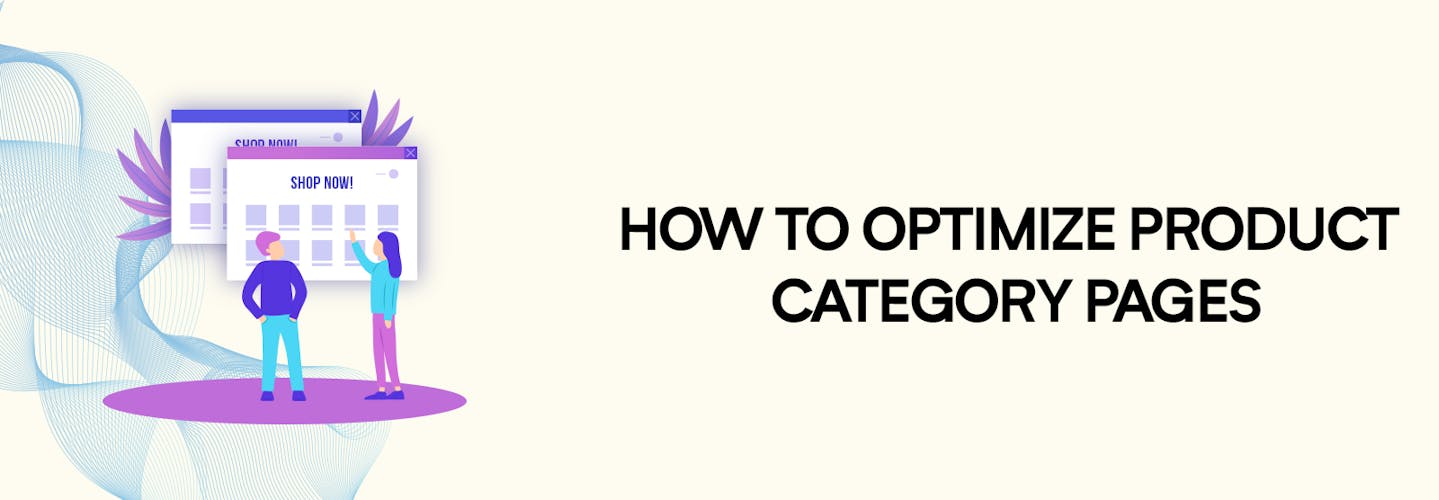
How to Optimize Product Category Pages on Your Ecommerce Website in 2025
Thinking about boosting your eCommerce sales in 2025-26?
Want to improve your website’s user experience and SEO? Wondering how to make your product category pages more effective?
The solution is straightforward!
You need to learn how to optimize your product category pages on your eCommerce website.
This strategy can help you improve user navigation, boost your SEO, and ultimately increase your sales.
But before you dive into the world of optimization, wouldn’t you like to understand why this strategy is more effective than simply adding more products to your site?
You’re definitely curious, aren’t you? So, let’s dive in and explore everything about optimizing product category pages for your eCommerce website in 2025.
Are you ready to learn?
What Is an Ecommerce Category Page?

When you’re shopping online, you probably notice that products are often organized into categories like “women’s clothing,” “electronics,” or “home decor.”
These categories exist to help shoppers find what they’re looking for quickly and easily. Ecommerce category pages are where these products live on a website, and they’re crucial for both the shopper’s experience and the success of an ecommerce business.
An ecommerce category page is a webpage on an ecommerce site that shows a group of products that share common characteristics.
These might be things like product type, color, size, or any other attribute that makes sense for the business.
For example, a fashion retailer might have categories for dresses, shoes, or accessories.
Category pages are important because they allow online shoppers to browse through similar products in one convenient place.
Rather than clicking through individual product pages one by one (which can be time-consuming), shoppers can get an overview of all the options available within a particular category.
This can help them make informed decisions about what to buy and ultimately lead to more purchases. In addition to being useful for shoppers, ecommerce category pages also have SEO benefits.
Search engines like Google rank each page on a website separately based on its content and relevance to certain keywords.
By optimizing each category page with relevant content and keywords related to the products it contains, businesses can improve their chances of ranking higher in search results when people search for those terms.
Why Category Pages Are Important on Ecommerce Sites
At first glance, category pages may seem like just another section of your website, but they play a crucial role in your ecommerce website’s success.
Category pages help organize your products into specific groups, making it easier for customers to navigate and find what they’re looking for.
These pages can also improve your site’s search engine optimization (SEO) by providing search engines with more relevant content to crawl.
One of the main reasons why category pages are important on ecommerce sites is that they can help increase the amount of time customers spend on your website.
When customers are able to easily find what they’re looking for, they’re more likely to stay on your site longer and explore other products.
The longer a customer stays on your site, the more likely they are to make a purchase. In addition, category pages allow you to highlight specific products or promotions.
By creating a visually appealing layout and featuring top-selling products or current promotions at the top of the page, you can catch customers’ attention and encourage them to add those items to their cart.
This tactic can be especially effective during peak shopping seasons such as Black Friday or Cyber Monday.
Overall, optimizing your ecommerce category pages is essential for improving customer experience and increasing sales.
By organizing your products effectively and strategically featuring top sellers and promotions, you can create an engaging shopping experience that keeps customers coming back for more.
Why Optimize Your Product Category Pages?
Product category pages are crucial for both user experience and SEO.
They help users navigate your website and find what they’re looking for, leading to improved customer satisfaction and higher conversion rates.
For search engines, well-structured and optimized category pages can rank higher, driving more organic traffic to your site.
The eCommerce landscape continues to evolve at a rapid pace. According to Statista, retail e-commerce sales worldwide amounted to approximately 5.2 trillion U.S. dollars in 2021 and are forecast to reach about 8.1 trillion dollars by 2026.
This means that the global e-commerce sales growth rate for 2025 is forecast at 8.9%, bringing global e-commerce sales worldwide to 5.9 trillion dollars.
One of the key battlegrounds where this competition plays out is on product category pages. These pages are not just a navigational tool for your customers, but also a gold mine for SEO opportunities.
How to do SEO for ecommerce category pages
Optimizing your ecommerce category pages for search engines is crucial to increase visibility, drive organic traffic, and ultimately, generate sales.
Here are some key steps to implement SEO for your ecommerce category pages.
1. Keyword Research

Keyword research is a fundamental part of SEO and it’s crucial to get this step right because it sets the foundation for your SEO strategy.
To start with, you need to understand what your potential customers are searching for. This involves identifying keywords relevant to your product categories.
For example, if you sell women’s shoes, you might want to target keywords like “women’s boots”, “running shoes for women”, “women’s sandals”, etc.
One way to find these keywords is to simply think from a customer’s perspective. What would someone type into a search engine if they were looking for your products? Jot down all the ideas that come to mind.
After brainstorming potential keywords, it’s time to use keyword research tools to validate your ideas and find more keyword opportunities.
There are many keyword research tools available, but some of the most popular ones include Google Keyword Planner, SEMrush, and Moz’s Keyword Explorer.
For example, if you use Google Keyword Planner, you can type in your brainstormed keywords and the tool will show you how often those terms are searched and how competitive they are. It will also provide you with a list of related keyword ideas.
Let’s say you enter “women’s boots” into Google Keyword Planner. The tool might show you related keywords like “ankle boots for women”, “women’s winter boots”, or “women’s leather boots”. These could all be potential keywords for your category page.
In addition to finding the most popular keywords, you should also consider long-tail keywords.
These are longer, more specific keyword phrases that visitors are more likely to use when they’re closer to making a purchase or when they’re using voice search.
They’re a bit trickier to find, but tools like Answer The Public can help.
Keep in mind that your goal is not to chase after the keywords with the highest search volume.
Instead, you should aim to find keywords that are relevant to your products, have a decent search volume, and a reasonable level of competition.
This balance will give you the best chance of ranking high in search engine results.
For instance, ranking for a broad term like “women’s shoes” might be very difficult due to high competition.
However, a more specific term like “women’s leather ankle boots” might be easier to rank for, even though it has a lower search volume.
After completing your keyword research, you should have a list of target keywords for each of your product category pages.
These keywords should be incorporated into various elements of your category pages, such as the URL, title tag, meta description, and content.
Optimize On-Page Elements
Once you have your keywords identified, it’s time to incorporate them into your product category pages. Here’s how to do that with the critical on-page elements:
2. Title Tag
The title tag is one of the most important SEO elements on your page. It’s displayed in search engine results and gives search engines and users a brief overview of the page’s content.
For example, if you have a category page for “women’s leather ankle boots”, a good title tag could be “High-Quality Women’s Leather Ankle Boots | YourBrandName”.
Remember to keep your title tag concise (Google typically displays the first 50-60 characters) and incorporate your primary keyword naturally.
3. Meta Description
The meta description is a short summary of a page’s content that appears under the title in search engine results.
While it doesn’t directly influence your rankings, it can affect click-through rates. A well-written meta description can entice users to click on your page rather than a competitor’s. Include your primary keyword and make the description enticing.
For example: “Explore our wide range of women’s leather ankle boots. Find the perfect pair to match your style at YourBrandName.”
4. Headers (H1, H2, H3, etc.)
Headers are used to structure your content and make it easy for both users and search engines to read.
The H1 tag should include your primary keyword and provide a clear description of the page content.
Subsequent headers (H2, H3, etc.) can be used to break up sections of your content and should include secondary keywords where appropriate.
5. URL Structure
The URL of your category page should be short, readable, and descriptive. It should also include your primary keyword.
For example, your URL could be ”www.yourbrandname.com/womens-leather-ankle-boots“.
This not only helps with SEO, but also improves user experience, as it’s clear to the user what they can expect to find on the page.
6. Page Content
Your category page should include descriptive, keyword-rich content.
This can be a brief introduction at the top of the page, describing the products in the category.
For example, a short paragraph about the variety, quality, and styles of women’s leather ankle boots you offer.
You can also include content at the end of the page, perhaps providing styling tips or explaining how your boots are made.
7. Image Alt Text
Search engines can’t “see” images, but they can read the alt text. This is a description of the image content and another opportunity to include your keywords.
For instance, if you have an image of a leather ankle boot, the alt text could be “women’s black leather ankle boot”.
By optimizing these on-page elements with your target keywords, you can help search engines understand the content of your category pages and improve your chances of ranking higher in search results.
Improve User Experience (UX)
User experience is a crucial factor in SEO. If your website is difficult to navigate, slow to load, or not mobile-friendly, users are likely to bounce off, which can negatively impact your rankings. Here’s how to optimize UX on your ecommerce category pages:
8. Site Speed
Slow page load times can frustrate users and lead to higher bounce rates. You can use tools like Google’s PageSpeed Insights to analyze your site’s speed and get recommendations for improvement.
For example, optimizing images, leveraging browser caching, and minimizing CSS can all help to improve your site speed.
9. Mobile Optimization
With the rise of mobile shopping, it’s crucial that your ecommerce site is mobile-friendly. This means your site should be responsive, ensuring it displays correctly on all devices, including desktops, tablets, and smartphones.
10. Navigation
Your website should be easy to navigate, with a clear and simple menu structure. This not only helps users find what they’re looking for quickly and easily, but also helps search engines understand the structure and content of your site.
For example, if you have a clothing store, you might have main categories for “Men”, “Women”, and “Kids”, with subcategories for different types of clothing like “Shirts”, “Pants”, “Shoes”, etc. Within these, you could have further subcategories for specific styles or materials.
11. Implement Filters and Sorting Options
Allow users to filter and sort products based on various attributes like price, popularity, ratings, etc.
This enhances the user experience by making it easier for customers to find exactly what they’re looking for.
For example, on a “Men’s Watches” category page, you might include filters for brand, price range, watch type (analog, digital, smart), and features (water-resistant, alarm, etc.).
12. Internal Linking
Internal linking refers to the links that connect your website pages. These links help users navigate your site and help search engines understand the relationship between different pages.
For instance, on a “women’s leather ankle boots” category page, you could have internal links to related categories like “women’s leather shoes” or “women’s ankle boots”.
You could also link to specific product pages within the category, or to relevant blog posts or guides.
13. User-friendly Design
Your site design should be clean and visually appealing, with high-quality images and easy-to-read text. Your product category pages should clearly display products with concise, informative descriptions and prices.
By focusing on these areas, you can provide a superior user experience, which can boost your SEO, increase your conversion rate, and ultimately drive more sales.
14. Leverage Schema Markup
Schema markup is a form of structured data that helps search engines better understand the content on your webpage.
By adding Schema markup to your ecommerce category pages, you can provide search engines with explicit clues about what your content means.
For instance, if you have a product category page for “Women’s Running Shoes”, you can use Product Schema to provide details like the product name, image, description, price, and availability.
This information can then be displayed directly in search results in the form of rich snippets, making your page more attractive to users and potentially improving your click-through rate.
Remember that Schema markup should be used accurately and honestly to represent your content. Misusing it (for example, by marking up inaccurate or misleading information) can lead to penalties from search engines.
You can use Google’s Structured Data Testing Tool to validate your Schema markup and ensure it’s correctly implemented.
By leveraging Schema markup, you can make your ecommerce category pages more SEO-friendly and attractive to users.
15. Implement a Breadcrumb Navigation
Breadcrumb navigation is a secondary navigation scheme that reveals the user’s location in a website or web application. In the context of an eCommerce website, this would display the path from the home page to the current category page.
For example, if you have a clothing website and a user is on the “Men’s T-Shirts” category page, the breadcrumb navigation might look like this:
Home > Men’s Clothing > T-Shirts
This has several benefits for SEO:
- User Experience: Breadcrumbs help users understand where they are on your website and navigate more easily. This can improve user engagement and decrease bounce rates, both of which are positive signals to search engines.
- Keyword Optimization: Breadcrumbs naturally contain relevant keywords and help reinforce to search engines what the page is about.
- Internal Linking: Breadcrumbs provide additional internal links that help spread link equity around your website.
To implement breadcrumb navigation, you can typically use features built into your eCommerce platform or website builder.
16. Generate High-Quality Backlinks
Backlinks, or inbound links, are one of the most influential factors in SEO.
They signal to search engines that your content is valuable and trustworthy, thereby improving your site’s authority and search rankings.
When it comes to eCommerce category pages, obtaining high-quality backlinks can be challenging but not impossible. Here are a few strategies:
- Content Marketing: Create valuable, engaging content that people will want to link to. This can be blog posts, infographics, videos, or other forms of content.
For example, if you sell camping gear, you might create a blog post on “Top 10 Camping Sites in the U.S.” and link to your “Camping Tents” category page within the post. If the post is well-written and informative, other websites might link to it, indirectly giving your category page a boost. - Influencer Collaborations: Partner with influencers in your niche who can review your products or feature them in their content. Ensure they link back to your category page.
For instance, a fashion influencer might showcase your clothing and link back to your “Summer Collection” category page in their blog or social media post. - Guest Posting: Write articles for other reputable websites or blogs in your industry. Within the article, you can link back to your category pages.
For example, you might write a guest post on a gardening blog about “How to Choose the Right Garden Tools” and link back to your “Garden Tools” category page.
Remember, the quality of backlinks is more important than quantity. Links from high-authority, relevant websites will have much more impact than those from low-authority or unrelated sites.
Also, ensure your backlinks come naturally and organically. Buying backlinks or using manipulative tactics can result in penalties from search engines.
By generating high-quality backlinks to your category pages, you can increase their visibility and rankings, driving more traffic and sales to your eCommerce site.
Improve Conversion Optimization

Conversion Rate Optimization (CRO) involves making changes to your website with the goal of increasing the percentage of visitors who complete a desired action, like making a purchase.
It’s a crucial part of enhancing your eCommerce category pages. Here’s how to optimize for conversions:
- User-Friendly Design: Make sure your category pages are well-designed and easy to navigate. Clear product images, concise descriptions, and a simple layout can all contribute to a better user experience, which can help increase conversions.
- Strong Call-to-Actions (CTAs): Encourage your visitors to take action with clear and compelling CTAs. Whether it’s “Add to Cart,” “Buy Now,” or “View More,” ensure your CTAs stand out and are placed strategically on your page.
- Optimize Page Speed: Slow page load times can frustrate users and lead to higher bounce rates. Optimize your page speed by compressing images, using a content delivery network (CDN), and minimizing the use of heavy scripts.
- Product Filters: Implement filters (by size, price, brand, etc.) to help customers easily find what they’re looking for. This can significantly improve the shopping experience and increase the likelihood of purchase.
- Customer Reviews: Include customer reviews and ratings on your category pages. They provide social proof and can influence a customer’s decision to buy.
- Urgency and Scarcity: Use tactics like limited-time offers or showing limited stock availability to create a sense of urgency and encourage immediate purchase.
- A/B Testing: Regularly test different elements of your category pages (like CTAs, product images, and descriptions) to see what works best for your audience.
Remember, the goal of CRO is not just to drive more traffic, but to make the most out of the traffic you already have.
By focusing on conversion optimization, you can improve your category pages’ performance, resulting in more sales and a higher return on investment.
Some of the Best Ecommerce Category Pages
When it comes to optimizing your ecommerce category pages, it’s always a good idea to take inspiration from other successful websites. Here are some of the best ecommerce category pages out there to help you get started.
1. Apple: Apple has always been known for its sleek and stylish designs, and their website is no different.
Their product category pages are clean and simple, with large images and minimal text. Each product is showcased in a way that makes it easy to see all its features at a glance.
The page also includes the option to filter products by color, storage capacity, price range, and more.
2. Zappos: Zappos is an online shoe retailer that’s well-known for its exceptional customer service. Their category pages reflect this commitment to customer satisfaction by providing helpful filters that allow you to find exactly what you’re looking for.
You can filter shoes by size, width, brand, color, price range, and even customer rating.
3. Sephora: Sephora is a beauty retailer that offers everything from makeup to skincare products. Their category pages are well-organized and visually appealing, with high-quality images showcasing each item in their inventory.
Sephora also includes helpful filters that allow customers to find products based on things like skin type or concern (e.g., acne-prone skin), ingredients (e.g., vegan), or even by brand.
By taking inspiration from these successful ecommerce sites’ category pages and applying some of their best practices into your own website design process will increase the chances of having an effective product display page with excellent user experience for your customers!
Conclusion
Optimizing your ecommerce category pages can have a significant impact on your website’s performance and sales. By implementing the best practices we’ve discussed and avoiding common mistakes, you can create engaging and user-friendly category pages that convert visitors into customers.
Remember to keep your target audience in mind when creating your category pages and use compelling images and copy to showcase your products. Another important aspect to consider is constantly monitoring and updating your category pages.
Regularly analyzing page performance, testing different layouts and design elements, and incorporating customer feedback can help improve user experience, increase conversions, and ultimately boost sales. Don’t be afraid to try new things or make changes if something isn’t working as well as you’d like.
Stay up-to-date with the latest trends and technologies in ecommerce website design. As technology evolves at a rapid pace, it’s important to keep pace with the latest tools that make optimizing your website easier than ever before.
By staying informed of industry trends, you’ll be able to stay ahead of the competition and offer an exceptional ecommerce experience for your customers. So go forth with these tips in mind optimize those product category pages and watch your sales soar!
FAQ’s:
1. How do you optimize a product page?
Product page optimization involves using high-quality images, writing detailed and keyword-rich product descriptions, including customer reviews, optimizing page load speed, and ensuring mobile-friendliness.
2. What makes a good category page?
A good category page has clear and descriptive category names, high-quality images, brief category descriptions, filters and sorting options, and is optimized for SEO and mobile viewing.
3. What are some leading practices when creating category pages?
Leading practices include using descriptive category names, optimizing meta descriptions and titles, including category descriptions, implementing filters and sorting options, and ensuring mobile optimization.
4. What is a product category page?
A product category page is a webpage that lists all the products within a specific category on an eCommerce website, helping customers navigate the site and find what they’re looking for.
5. Why are category pages important for SEO?
Category pages are important for SEO as they help search engines understand the structure of your website and the products you offer, and they provide opportunities to target specific keywords, improving your site’s visibility in search results.








